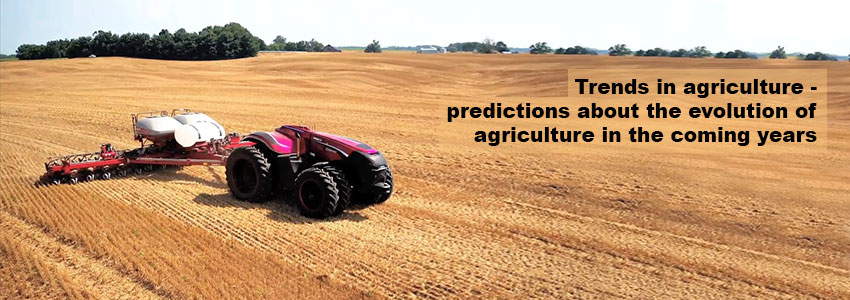Trends in agriculture - predictions about the evolution of agriculture in the coming years
 Trends in agriculture - predictions about the evolution of agriculture in the coming years
Trends in agriculture - predictions about the evolution of agriculture in the coming years
Due to the growing population, the demand for food is increasingly higher, but the land available for agriculture is the same or even less. In an attempt to maximize production, agricultural engineers began to use technology more and more. It is expected that, in the coming years, the technology will enable farmers to achieve record production and minimize losses at the same time. Autonomous and semi-autonomous robots, as well as fully automated machines, will slowly replace humans and will execute agricultural operations extremely fast, thus improving crop efficiency, yield and productivity.
Prototypes of Smart Agricultural Machines
Recently, a new tractor concept was revealed in the US by CNH Industrial, a global leader in agricultural equipment. The company presented a tractor that is 100% autonomous, independent, it does not need a driver and can be used 24 hours a day. This new machine concept has a controllable, easy-to-program interface, allowing sowing, planting, cultivation and other agricultural operations. The machine is equipped with a custom software, cameras, sensors and a GPS system. Thus, the farmer can even watch live, from an office, how the machine works alone in the field or he can work in parallel in a classic tractor. He needs a simple console in the form of a tablet, with which to control the autonomous tractor, by setting and monitoring its operating parameters.
There are other manufacturers and distributors of agricultural equipment, like the American company AGCO, who announces the automation of smaller equipment to avoid soil compaction under the machines’ weight. Currently, AGCO is testing small robots for the same operations as those executed by massive machines, but with a smaller financial investment from the farmer.
Technology vs. Man
Rising labor costs in agriculture, as well as the more affordable prices for cutting-edge technology, prove that the automated, robotized agriculture is very close to reality. Technology availability will lead to an agriculture in which man will be less and less required. Basically, all costs for a semi-automatic or automatic machine could reach the same level as those for workforce payment, and this will determine big farmers to opt for intelligent machines. And because technology advances rapidly, lubricants keep up with the innovations, too. Any agricultural machine, regardless of the complexity of the integrated technologies, needs maintenance and lubricants play an essential role in extending an engine’s life and in increasing machine efficiency during use.
The giants from Goldman Sachs, one of the biggest bank holding companies worldwide, estimate that progress in agricultural technology – including autonomous vehicles, robots, drones, irrigation, fertilizing or planting systems – could increase the productivity of farms with more than 70% by 2050.
In the future, it will be possible to integrate such advanced technologies in the farmers’ entire machinery fleet. For now, there are only prototype machines, but experts expect from 2020 onwards to see in the US the first such smart machines at work. Thus, the next 10 years, the agriculture as we know it today will disappear.







